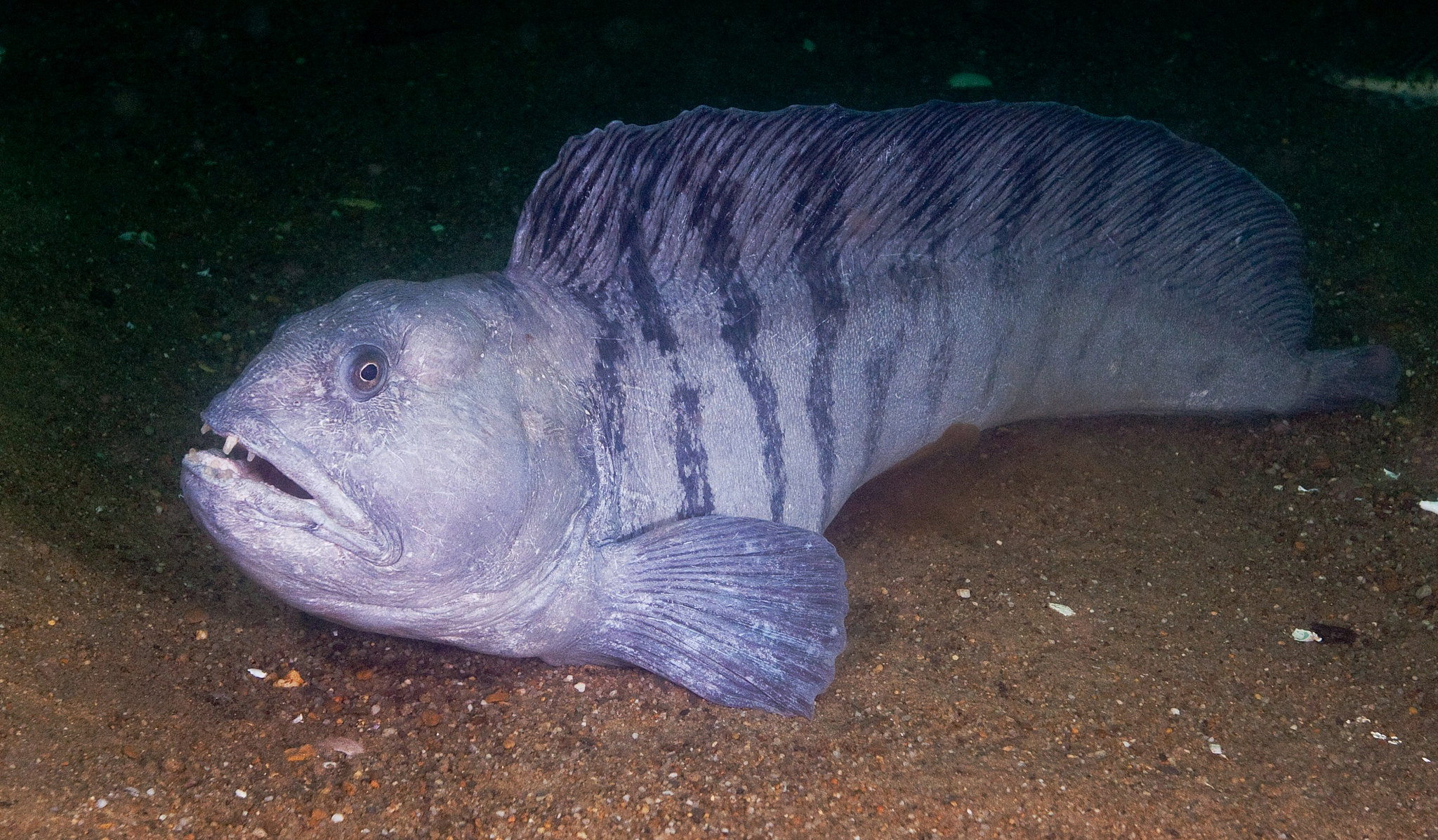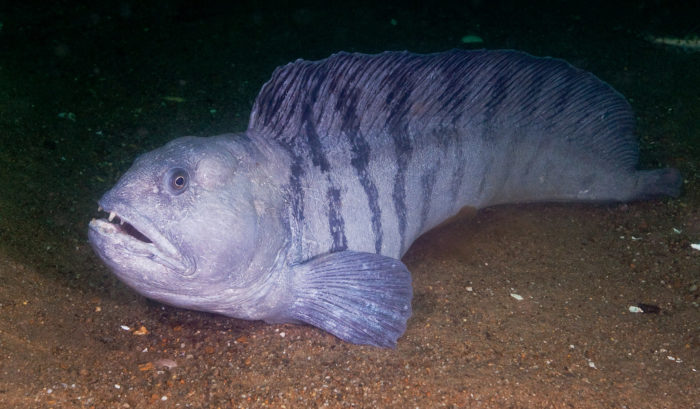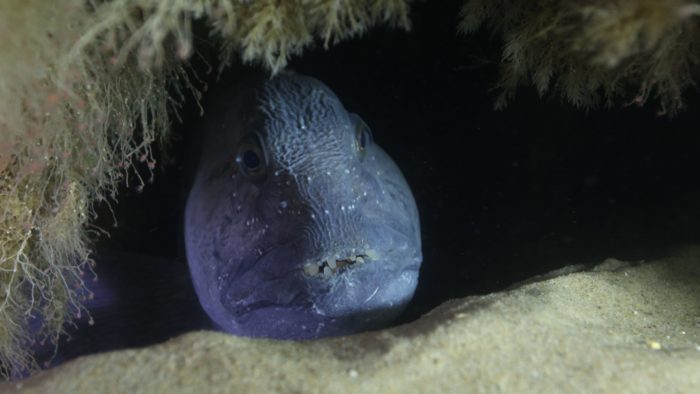
Sea Wonder: Atlantic Wolffish

Photo credit: NOAA Office of National Marine Sanctuaries
Atlantic wolffish (Anarhichas lupus) are often confused for eels thanks to their long, eel-like bodies, prominent teeth, and affinity for rocky habitats, but they are actually more closely related to sculpins than eels. Their intimidating appearance is matched by their voracious appetites and aggressive hunting strategies. The good news is that these incredible fish are pretty shy around humans and won’t use those chompers to bite unless they are provoked.
Description
Known as wolf eels, Atlantic wolffish have long and slender eel-like bodies. Their most notable features include the large teeth that protrude from their mouths even when closed. They have multiple rows of specialized teeth, which they lose and replace annually due to the damage their hard-shelled prey can cause over time.
Atlantic wolffish appear in a range of colors from olive-green, purplish-brown, or a striking blue-gray and a single dorsal fin span’s the fish’s entire back, and another spanning from its tailfin and along its ventral side. This species can grow to be six feet long and weigh as much as 50 pounds!
Diet & Habitat
The strong jaws and large teeth that Atlantic wolffish have allow them to feed on hard-shelled organisms like crustaceans, mollusks, and echinoderms. Common prey species include hermit crabs, urchins, green crabs, clams, and starfish. These fish are keystone species, which means their predation keeps other animal populations – like urchins, green crabs, and starfish – in check and their ecosystems in balance; without Atlantic wolffish, these populations could grow too quickly and lead to smaller populations of important species that build the foundation of marine and coastal food webs. To hunt, wolffish use ambush predation in which they remain still and attempt to blend into their environment so unsuspecting prey will approach them; when they come close enough, the wolffish lunges, using their teeth to trap and their jaws to crush their prey.
Atlantic wolffish spend most of their time in a particular home range, but they do leave that range to find colder waters that are more suitable for spawning season. Their range spans the northern Atlantic Ocean, venturing as far north in the western Atlantic as the Davis Strait, Nunavut territory in Canada. The largest populations occur in the Great South Channel, Georges Bank, and the Gulf of Maine, and they are found in and near Stellwagen Bank National Marine Sanctuary. This species is benthic, meaning that they live along the hard, rocky ocean floor and nest in small caves or nooks. They live at depths between 66 and 1,640 feet in cold water as low as 30°F to 52°F (-1 to 11°C) and their bodies produce a natural antifreeze that allows them to survive and remain active in nearly freezing waters.
Life History
Atlantic wolffish can live as long as twenty years old and have a late maturity cycle, being incapable of sexually reproducing until they are eight to ten years old. Wolffish form breeding pairs in spring to summer and mate in the fall. The Atlantic wolffish utilizes internal fertilization to reproduce, which is significantly different from the broadcast spawning of most other fish species. Females hold their eggs in utero for four to nine months and release them when water temperatures are just right. Once the males start to protect their eggs, they stop feeding and become extremely aggressive towards anything that comes into their territory, even other wolffish that are not their mates. This intensive level of parental care is rare among fishes.
Atlantic wolffish eggs are the largest of any fish, with diameters of 5.5 to 6 millimeters. They have an opaque, yellowish tint and clump closely together, which promotes warmth. It can take between three to nine months for the fish eggs to hatch after being released, which is also based on water temperature. They stay near their hatch sites at the bottom of the ocean during the larval stage and it can take a few hours to one week before the larvae are ready to venture into the water column, where they are pelagic for two weeks to two months. Once they reach their juvenile stage, wolffish are much more solitary and they reach maturity when their bodies reach their maximum size.
Threats & Conservation
Since Atlantic wolffish are keystone species in Atlantic food webs, the health and abundance of their populations is important to study and manage. Since it is a slower growing species, even small declines in population can pose significant threats to the species since it can take longer to replace individuals than we see in other species of fish.
The effects of climate change and global warming can pose risks to this cold-water species. They are sensitive to increasing ocean temperatures and their hard-shelled prey are vulnerable to the effects of ocean acidification. The most common and visible threat to the species at present is trawling by commercial fishing vessels, which can cause significant damage to the wolffish’s rocky habitat and catch them in the nets during the process, even if they are not the targeted species.
The Atlantic Wolffish species has rapidly declined in recent decades, which resulted in being listed as a Species of Concern by the National Marine Fisheries Service in 2004. Despite a steadily declining population, the National Marine Fisheries Service has not yet declared it as a threatened or endangered species, which would earn it the protections offered by the Endangered Species Act.

Photo credit: Matthew Lawrence
